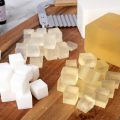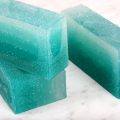Working out a simple business plan
The longer, detailed variety of business plans generally document your industry and overview the market, analyze competitors in the field, draw-up plans for marketing and management structures, describe operational plans of facilities and equipment, and thoroughly analyze financial requirements for running the business and generating profits. They cover a lot! But, we’re not going to work on these types of detailed business plans (though some of you might, at some point, need to do one if you decide to pursue a bank loan or line of credit for company expansion). For now, we’re going to cherry-pick some of the most useful, and relevant, parts for putting together a simpler, and easy-to-do version.
To generate a plan for your business, you’ll want to spend a little time researching and exploring the soapmaking industry. You can do this through magazines or even by doing a bit of online research. Good places to start are soapmaking forums such as http://soapdishforum.com/ or http://www.teachsoap.com/forum/ or some of the YahooGroups for soapmaking. You could also extend your reading to the health and beauty industries in general. Reading up on these industries will give you good insights on the latest trends. And having this kind of knowledge will certainly help you make better business decisions overall. If you’ve been in the soap world for a little while, you probably took care of this step without even realizing that getting a good background knowledge was important for your plan.
The next part of the plan involves figuring out your customers. Who are your customers? And, who are the customers you would like to sell to? If, right now, you’re selling to people at farmers’ markets and craft fairs, ask yourself: “Who is attending these markets and fairs?” And, then take notice of who is coming into your booth and making purchases. Are they women? Are they mothers? Are they groups of friends? Once you figure out these questions, you can start to make product offerings that appeal to these specific types of customers.
For example, if you find that many of your customers are mothers, you can create soaps that are fun for children. Since mothers are always looking out for fun products that kids like and have entertainment value (i.e. cute animal or hidden-object type soaps), you can make soaps that meet this need. It’s important to drill down to as much detail as you possibly can. Is that same mother wearing Birkinstocks or the latest Manolo Blahnik? Does she dye her hair? Is she carrying her baby in a sling or pushing the baby in an $1000 Stokke Xplory stroller. You probably shouldn’t be designing hemp soap with patchouli essential oil for the Manolo Blahnik–wearin‘, $1000 stroller-rollin‘ mom. When you find unique ways to meet your customers’ needs, you increase the likelihood of making sales to them. Being clear on who your customers are will help you to do this.
When creating your plan, you’ll also need to know who your competitors are. You’ll need to think about what exactly they offer. Understanding your competitors will lead you to your own unique value proposition. This is the unique offering that you bring to your customers that your competitors cannot. It’s what gives them value. And it’s how that offering positions you in relation to your competitors.
At a farmer’s market, there are only so many people actually in the market to purchase soap. If they can choose between your soap, and the soaps of a competitor a few booths down, what is it that will make them choose your soaps instead of your competitor’s products? Is it quality? Is it variety? Is it price? Think about the advantages your product offers as well as the advantages your competitors offer.
A word of caution: it’s tempting to consider everyone your “competitor” and want to go all draconian and drive them out of the marketplace.This is one way of doing business but I don’t think it’s a healthy way of doing business. I prefer to think of other people selling soapmaking supplies on the internet as “fellow suppliers” rather than “competitors”. The two terms mean the same thing but the feeling bethind them is vastly different. It doesn’t mean I don’t pay attention to them or try and figure out a niche they don’t have. I still do that. But, I do so in a spirit of trying to improve our company and hopefully, the entire industry.
At Bramble Berry, our unique value proposition used to be that we got almost all our orders out within 1 business day of the order being placed. Then, a few other fellow vendors started doing that. So, that unique value proposition started becoming more of a tablestake. So, now our unique value proposition is in trying to improve the customer experience. It’s something we want to be better at than our competitors. And so, we’re working really hard to give our customers lots of different ways to talk to us such as through blogs (this one and me visiting as many of yours as I can), soap forums, Twitter, Facebook, soap making weekends, and by giving talks at regional and national gatherings. We believe that by doing this, we give ourselves an edge over our fellow suppliers.
Tonight’s homework is to identify your current customer and identify your ideal customer, in writing. Write down as much detail as you can come up with about them (age, sex, income range, likes, dislikes, where they shop, what they drive, kids, professions – it all helps). It doesn’t have to look fancy. Just brain dump onto paper. At the end of this process, we’ll put it all together in a coherent format.
Tomorrow we’ll look at another feature of the business plan: how to evaluate your strengths, weaknesses, opportunities and threats.
Looking for another part in the “Kickstart Your Business” series?
Part 1 – Defining Your Business
Part 5 – Using Your Vision To Inspire
Part 7 – Put Your Goals To Action
Part 8 – Surround Yourself Well
Part 9 – Endless Possibilities






I really had to think about where I was going with my hobby and your blog has helped me considerably! Thanks so much.
Thank you Cyndi and Anne-Marie for pointing the way out of the chicken-and-egg problem. I’m working on it!
Bliss Mistress, My understanding is that the CPSIA will be focusing on toys and durable goods and the FDA will continue to monitor the beauty market. That said, you’ll want to check with your insurance about getting into the children’s market and make sure you’re adequately insured for that.
Anonymous, If you haven’t started selling, I’d sit down and spend some time trying to figure out who you would want your customers to be in an ideal world. What do you want your niche to be? Who do you need to sell to in order to “own” your niche?
Thank you Anne-Marie for publishing this series. I am currently going through the rigours of getting my business off the ground. Having to go back to the grind at the office after two weeks off has made me even more determined, so this is great timing!
Thanks again 🙂
I’ve written business plans in the past for my other business and I find them to be very daunting. I can honestly say that I am looking forward to doing this with you. Maybe it’s the concept of really breaking it down into small pieces (i know other plans do to.) I don’t really know what it is but keep doing what you’re doing, it’s working for me.
To Anonymous:
The chicken and the egg. I hear what you are saying. What I would suggest for you is to think about what market it is you want to concentrate on. The Birkenstocks? The 1000.00 shoes? The kids? Build a plan from there, istead of trying to cover everything in the beginning. You’ll drive your self crazy and get discouraged. Remember you can always add things as you go along.
Cyndi
This is a great series. Thank you.
Michelle in NV
Anne Marie this is very interesting,I have been working on this for the last few months,it makes sense.I have worked a lot harder on the soaps and products I sell to please different types of customers.I have some high end clients and they shop for different items.
And as far as the customer service,I started soap making at Michaels,out of nowhere I saw the base and bam I was hooked,then I found brambleberry,months later I found other suppliers,and although Florida is so far away I really appreciate the customer service with you guys,wow,and I admire you,and the time you devote to your customers and fans!!
Dani 🙂
Excellent post and whether or not one writes the business plan, knowing your market can save you money by avoiding expensive mistakes or experiments that don’t lead to products. On the other hand, I’m at a place where I’m making what delights my senses and that means beautiful colors and scents that delight me… and it works. Plus… much of my life I have not been able to smell because of allergic reactions and such. Now that I’m on drugs that handle this for me, it’s a whole new world and that is one of the main reasons I’m a soaper!
Chicken and egg problem. How do you know who your customers are if you haven’t started selling yet?
Yep, a post that can be used directly! I love the homework portion as it helps keep me honest! I have also shared this blog with friends of mine in small biz but different industries. It’s good stuff!
I can’t begin to tell you how much I appreciate this series you’re doing. It’s very timely for me, and I’m going to make my kids work on it with me. 8)
Thanks so much, Anne-Marie!
Love this series of posts you’re doing. Something you said in this post inspired a question, not sure if you can answer it or not…
We were planning to expand our line in 2009 to include baby and children’s products. However, with the new CPSIA, some have said that ALL products that could “potentially be used” by children would have to go through the same testing protocol. Not just toys. Also blankets, clothing, and soap, etc. I know that you have done far more research on this often vague and maze-like law and others – is that your reading of it?
GREAT topic Anne Marie. Well done!
Sindy who can’t sign in today?
I respect your position on competitors. I believe that competition is very healthy- it keeps you at the top of your game and keeps you thinking & developing. In the soapmaking community, I have been fortunate that many fellow soapmakers believe this same thing. To date, I have found one competitor that didn't believe this… we were a very new company and I think they felt we were invading their territory at the craft fairs. It was too bad. However, I still sent customers to them if we didn't have what they were looking for. Almost all of the customers, came back and bought something from me as well regardless of whether they bought from this competitor or not.
Very good description of getting to know your customers. Many times, I sit at crafts shows and just watch while my hubby works the booth. From the get go, both (hubby & I) saw similarities among customers. I usually review other soapers' websites prior to any shows. This way I know what they offer, their price, packaging, etc.